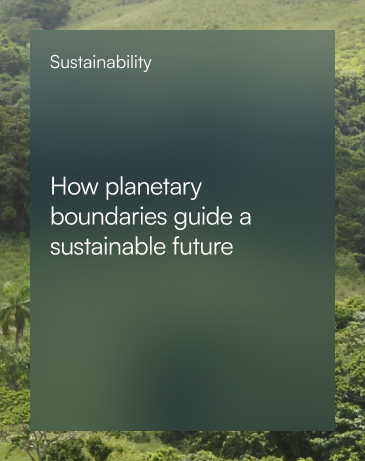How planetary boundaries guide a sustainable future
Enter the planetary boundaries concept—a powerful framework designed to help humanity identify and respect the Earth’s biophysical limits.

In recent years, there has been a growing realization that our planet’s resources are finite. This means we cannot continue consuming and polluting at current rates without affecting the very systems that sustain us. Enter the planetary boundaries concept—a powerful framework designed to help humanity identify and respect the Earth’s biophysical limits.
What are the planetary boundaries?
Planetary boundaries are scientifically grounded thresholds for nine critical Earth systems. Think of them as the guardrails within which humanity can operate safely. When we remain within these boundaries, Earth’s systems remain stable and resilient. When we push past them, we risk triggering significant—and potentially irreversible—environmental changes. Introduced in 2009 by a team of Earth system scientists, this framework underscores that everything on our planet is interconnected. For example, excessive fertilizer runoff doesn’t just affect local rivers—it also contributes to ocean dead zones. Understanding and respecting these boundaries can help avoid worst-case scenarios such as catastrophic climate change or mass biodiversity loss.
The nine boundaries: a quick overview
Table 1: Overview of the planetary boundaries. Red status indicates that the boundary has been transgressed. Green box indicates that the boundary has not been transgressed.

Current research indicates that several of the planetary boundaries have already been crossed—including those related to climate change, biosphere integrity, land-system change, and biogeochemical flows (nitrogen and phosphorus). In total, as of 2023, six out of the nine planetary boundaries had been crossed. Scientists warn that continuing this path could destabilize crucial Earth systems, pushing our planet toward more unpredictable conditions. While there have been positive strides—such as the phasedown of ozone-depleting substances—other areas (like freshwater use and the introduction of novel chemical entities) are rapidly approaching critical thresholds. This highlights the need for urgent, coordinated global efforts to reduce pressure on our planet’s systems and steer humanity back into a “safe operating space.” That is also why they matter as a measuring tool.
Firstly, they can assist us in highlighting critical thresholds we should not cross if we want to sustain human civilization in its current form. Exceeding them could trigger abrupt or irreversible changes—think massive biodiversity losses or runaway climate change manifesting as weather abnormalities and other damaging environmental events that leads to both humanitarian and economic destruction. Secondly, they are designed for interconnectedness; All nine boundaries interact. For instance, tackling climate change can influence water availability and land use. Likewise, failing to reduce pollution could undermine efforts to maintain healthy ecosystems. Last but not least, the boundaries provide a tool that are grounded in peer-reviewed research. The planetary boundaries framework provides a robust, evidence-based foundation for setting environmental goals and policies.
Figure 1: The evolution of the planetary boundaries framework

How can businesses leverage the framework that the planetary boundaries provide?
There are several ways in which a business can leverage the framework that the planetary boundaries can be transformed into.
1. To set science-based targets: Translating planetary boundaries into specific, measurable goals allows organizations to address sustainability on a global scale. For instance, setting science-based carbon emission reductions aligns with the climate change boundary.
2. To identify strategic opportunities: By looking at each boundary, companies can spot opportunities for innovation—such as creating low-impact products, developing regenerative agricultural practices, or investing in circular economy solutions.
3. To manage risks: Crossing these boundaries can disrupt supply chains, worsen resource scarcity, and lead to stricter regulations. Integrating planetary boundaries into strategic planning helps mitigate such risks and fosters long-term resilience.
4. To enhance reputation and stakeholder trust: Consumers, investors, and regulators increasingly favor businesses that proactively address environmental challenges. Aligning operations with planetary boundaries can bolster brand reputation and stakeholder confidence.
5. To create opportunity for collaboration to achieve greater impact: No single organization can solve these issues alone.Partnerships among companies, governments, NGOs, and local communities can pool resources and drive large-scale change.
Calling for more action
The planetary boundaries concept reminds us that Earth’s ecosystems have limits. By acknowledging these constraints and actively working to stay within them, we can ensure a stable, resilient environment—not just for our own operations, but for society at large.
Companies that proactively embrace these boundaries will be better positioned to navigate future disruptions, attract conscientious consumers, and help lead the world toward a truly sustainable future.
Have thoughts on planetary boundaries or want to learn more about how to integrate them into your business strategy? Reach out to us directly. Together, we can create a blueprint for long-term prosperity that respects the Earth’s finite limits.
Are you interested to get to know more about this topic?
Here is some further reading suggestions for you:
• Stockholm Resilience Centre – Planetary Boundaries
• Science-Based Targets Initiative
• World Business Council for Sustainable Development
• United Nations Environnent Programme (UNEP)
Disclaimer: This blog is a simplified introduction to a complex topic. For detailed scientific resources, check out the latest peer-reviewed articles on planetary boundaries.




